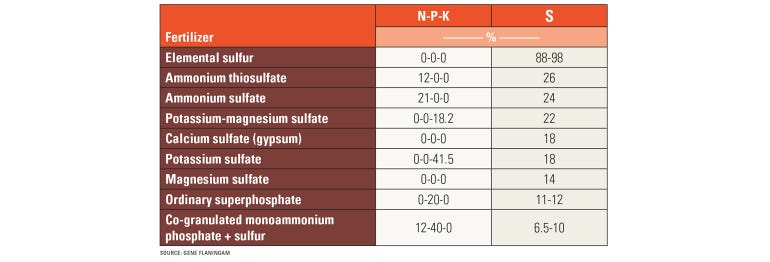February 27, 2019

I’m going to apply sulfur on all my soybean acres this spring. What sources are available? Which source(s) do you suggest? How do I apply it, and at what rate?
The Indiana certified crop adviser panel answering this question includes Gene Flaningam, Flaningam Ag Consulting LLC, Vincennes; Greg Kneubuhler, G&K Concepts, Harlan; and Tom Stein, manager of the Boswell and Templeton branches for Ceres Solutions Cooperative.
Flaningam: Applying 15 to 20 pounds of actual sulfur per acre is ideal. Rates of fertilizer will need to be adjusted according to analysis. Elemental sulfur is a slow-release product that should be applied at least six to eight weeks prior to planting. If you want to apply a liquid product, approximately 8 gallons of ATS would give you 23 pounds of actual sulfur. The most common dry source would be AMS. A rate of 100 pounds per acre would give you 24 pounds of actual sulfur. Sulfur can be applied at planting with a floater truck or applied as topdress with a high-clearance spinner.
See the table below for various sulfur sources. Note that N is nitrogen; P is phosphorus; K is potassium; S is sulfur; and the percentage is the amount of actual element per 100 pounds of product. For example, ammonium sulfate contains 21 pounds of N and 24 pounds of S per 100 pounds of AMS.

Kneubuhler: There are many ways to apply sulfur to soybeans. It depends somewhat on price, availability and logistics. If I ignored all costs and logistics, low rates of bulk scrubber or mined gypsum are the easiest ways to get a sulfur load. However, that avenue is quickly becoming cost-prohibitive. Logistics become an issue too — that product needs to be spread just like lime.
The next best ways are with ammonium sulfate (21-0-0-24S) or pelletized gypsum. From a cost and logistical standpoint, these two products make the most sense. Personally, we like to see spring application rates of 20 to 25 pounds of actual sulfur per acre to achieve those kind of sulfur loads.
Elemental sulfur can be an option, but that requires more forward planning rather than a springtime application.
Stein: Elemental sulfur, ammonium sulfate, gypsum, potassium magnesium sulfate known as K-Mag, potassium sulfate and ammonium thiosulfate are the most common sulfur sources available. I would recommend using sulfate forms since that is the form of sulfur readily available for plant growth. ATS would work well because that product contains 50% of its sulfur in the sulfate form. Since it’s a liquid, it can be used as a carrier for burndown or residual herbicides and applied prior to crop emergence. Perform a jar test just to make sure there are no compatibility issues before spraying.
Some dry products such as ammonium sulfate and potassium sulfate would be good choices to broadcast ahead of planting. K-Mag would be a good choice on soils that are low in magnesium due to the type of ag lime used to correct and balance pH. I would apply about 25 pounds of actual sulfur per acre broadcast on coarse, low-organic matter soils, and 15 pounds of actual sulfur per acre broadcast on medium- to fine-textured soils.
You May Also Like




